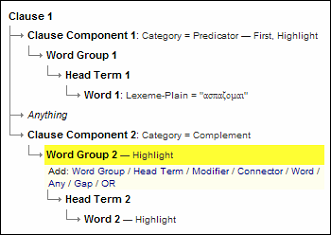Read the first two posts in this series: 1 | 2.
Romans 16 has several examples of this form. Verse 3 offers a good sample:
Greeting Form in Ro 16.3
Description of Form
Mullins describes the components of the greeting form as follows:
The elements of the greeting are: 1. the greeting verb (some form of ἀσπάζεσθαι); 2. indication of the person who is to do the greeting; 3. indication of the person who is being greeted; 4. elaborating phrases. The first three are the basic elements of the greeting. The fourth is optional. These elements may be expressed differently in the three types of greeting. In the first-person and second-person type of greeting, elements one and two are accomplished at the same time by the verb.[1]
As noted in the above quotation, Mullins identifies three different types of the form, one for each grammatical person of the greeter. Thus there are first-person, second-person and third-person forms. Because component 2 can be done with either grammatical person of the verb (first and second person) or a pronoun (third person), the pronoun is essentially optional when considering a syntax-based query.
Therefore a syntactic search only need attend to two criteria:
- The greeting verb (ἀσπάζομαι)
- Indication of the person being greeted.
Mullins does not provide a definitive list of New Testament instances, but he does mention epistles that contain instances of the greeting form: “It appears in the letters of Paul, extensively, and in the Pastorals, Hebrews, I Peter, and II and III John.”[2]
The Form in OpenText.org SAGNT
Locating the greeting form involves searching for clause-initial instances of ἀσπάζομαι (as a predicator component) that also have a complement clause component. The complement denotes what completes the predication, thus direct objects are included in the sorts of things that complements encode.[3] Including the complement therefore includes an “indication of the person being greeted”.
Structure of Greeting Form
This query returns 69 instances, though the results are not perfect. Instances in Mark (15.18) and Acts (21.7, 19; 25.13) are returned in addition to hits in Paul, Pastorals, Hebrews, First Peter, Second John and Third John.[4] Romans, with an extensive greeting section in chapter 16, contains the bulk of the matches.
Bibliography
Mullins, T.Y., “Greeting as a New Testament Form”, JBL 87 (1968), pp. 418-426.
Endnotes
[1] Mullins, p. 419.
[2] Mullins, p. 424.
[3] An aside: One could limit greetings to those that list personal names in the complement by restricting the complement to containing a head term word that is also tagged as Louw-Nida domain 93, the “personal name” domain. But this would skip over other valid instances of greetings like Php 4.22, “All the saints greet you”.
[4] Based on Mullins’ article, my guess is that only the Mark and Acts references are extraneous; the rest are valid.






